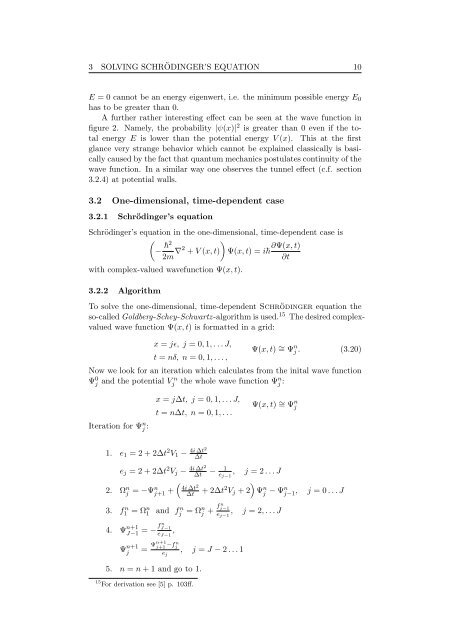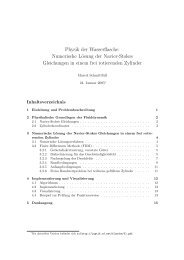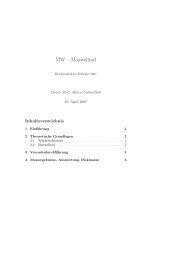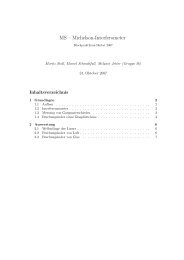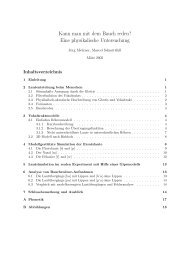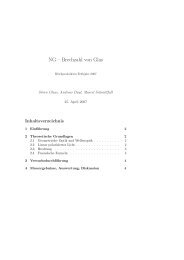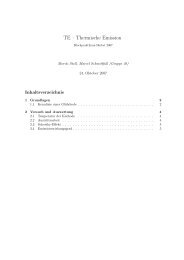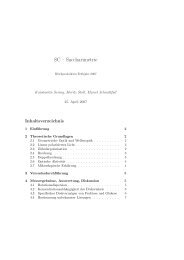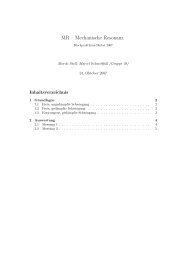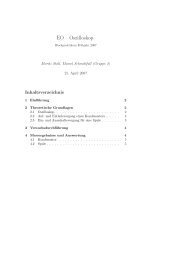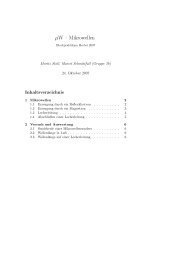JavaPsi - Simulating and Visualizing Quantum Mechanics (english)
JavaPsi - Simulating and Visualizing Quantum Mechanics (english)
JavaPsi - Simulating and Visualizing Quantum Mechanics (english)
You also want an ePaper? Increase the reach of your titles
YUMPU automatically turns print PDFs into web optimized ePapers that Google loves.
3 SOLVING SCHRÖDINGER’S EQUATION 10<br />
E = 0 cannot be an energy eigenwert, i.e. the minimum possible energy E0<br />
has to be greater than 0.<br />
A further rather interesting effect can be seen at the wave function in<br />
figure 2. Namely, the probability |ψ(x)| 2 is greater than 0 even if the total<br />
energy E is lower than the potential energy V (x). This at the first<br />
glance very strange behavior which cannot be explained classically is basically<br />
caused by the fact that quantum mechanics postulates continuity of the<br />
wave function. In a similar way one observes the tunnel effect (c.f. section<br />
3.2.4) at potential walls.<br />
3.2 One-dimensional, time-dependent case<br />
3.2.1 Schrödinger’s equation<br />
Schrödinger’s equation in the one-dimensional, time-dependent case is<br />
<br />
− 2<br />
2m ∇2 <br />
∂Ψ(x, t)<br />
+ V (x, t) Ψ(x, t) = i<br />
∂t<br />
with complex-valued wavefunction Ψ(x, t).<br />
3.2.2 Algorithm<br />
To solve the one-dimensional, time-dependent Schrödinger equation the<br />
so-called Goldberg-Schey-Schwartz-algorithm is used. 15 The desired complexvalued<br />
wave function Ψ(x, t) is formatted in a grid:<br />
x = jɛ, j = 0, 1, . . . J,<br />
t = nδ, n = 0, 1, . . . ,<br />
Ψ(x, t) ∼ = Ψ n j . (3.20)<br />
Now we look for an iteration which calculates from the inital wave function<br />
Ψ 0 j<br />
<strong>and</strong> the potential V n<br />
j the whole wave function Ψn j :<br />
Iteration for Ψ n j :<br />
1. e1 = 2 + 2∆t 2 V1 −<br />
ej = 2 + 2∆t 2 Vj −<br />
2. Ω n j = −Ψn j+1 +<br />
x = j∆t, j = 0, 1, . . . J,<br />
t = n∆t, n = 0, 1, . . .<br />
4i ∆t2<br />
∆t<br />
4i ∆t2<br />
∆t<br />
Ψ(x, t) ∼ = Ψ n j<br />
1 − , j = 2 . . . J<br />
ej−1<br />
4i ∆t 2<br />
∆t + 2∆t2 Vj + 2<br />
3. f n 1 = Ωn1 <strong>and</strong> f n j = Ωnj + f n j−1<br />
, j = 2, . . . J<br />
ej−1<br />
4. Ψ n+1<br />
J−1 = − f n J−1<br />
eJ−1 ,<br />
Ψ n+1<br />
j<br />
Ψn+1<br />
j+1<br />
= −f n j<br />
, j = J − 2 . . . 1<br />
ej<br />
5. n = n + 1 <strong>and</strong> go to 1.<br />
15 For derivation see [5] p. 103ff.<br />
<br />
Ψn j − Ψnj−1 , j = 0 . . . J


